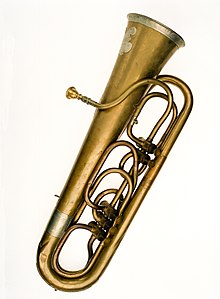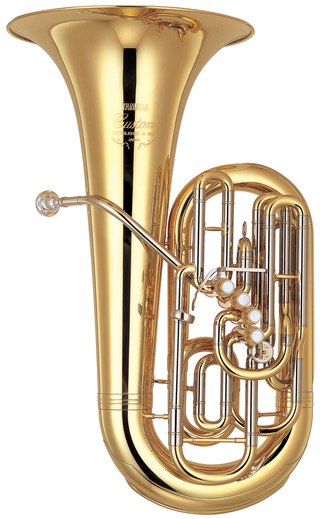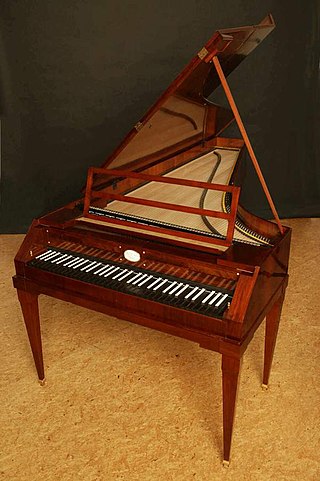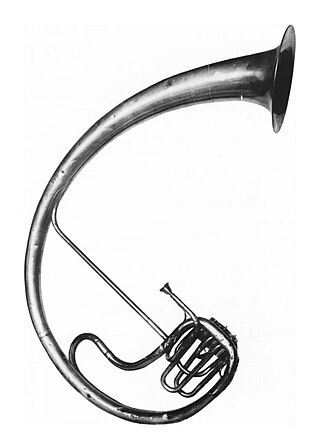Johann Gottfried Moritz (1777 - 23 July 1840) was a German musical instrument builder, best known as one of the inventors of the modern tuba.

Johann Gottfried Moritz (1777 - 23 July 1840) was a German musical instrument builder, best known as one of the inventors of the modern tuba.

Moritz was born in Berlin in 1777. From 1799 he apprenticed as an instrument builder in Leipzig, then in 1805 moved to Dresden. From 1808 he returned to Berlin and opened his own workshop. In 1819 he was appointed as instrument maker to the Prussian royal court, where he worked for most of his career. [1]
Together with Wilhelm Friedrich Wieprecht, the director of the royal military music corps, Moritz was successful in greatly improving the valve system used on early brass instruments. These valves designed by Moritz and Wieprecht were known as “Berliner Pumpen”, and were more reliable than the previous models. Shortly after that, Moritz invented the "Bass tuba in F", the first modern tuba, which he patented in 1835. Wieprecht included the new tuba in military bands almost immediately, where its descendants remain used as the bass instrument in marching bands today. The oldest remaining original tuba from Johann Gottfried Moritz's workshop is today held in the Musikinstrumenten-Museum Berlin.
In 1835, Johann Gottfried retired from building instruments, with the manufacturing business being taken over by his son Carl Wilhelm Moritz. Their sons and grandsons kept the business in family hands more or less continuously over the following century and a half, until economic issues following World War 2 forced its closure in 1959. [2]

The euphonium is a medium-sized, 3 or 4-valve, often compensating, conical-bore, tenor-voiced brass instrument that derives its name from the Ancient Greek word εὔφωνος euphōnos, meaning "well-sounding" or "sweet-voiced". The euphonium is a valved instrument. Nearly all current models have piston valves, though some models with rotary valves do exist.

The trombone is a musical instrument in the brass family. As with all brass instruments, sound is produced when the player's vibrating lips cause the air column inside the instrument to vibrate. Nearly all trombones use a telescoping slide mechanism to alter the pitch instead of the valves used by other brass instruments. The valve trombone is an exception, using three valves similar to those on a trumpet, and the superbone has valves and a slide.

The tuba is the lowest-pitched musical instrument in the brass family. As with all brass instruments, the sound is produced by lip vibration – a buzz – into a mouthpiece. It first appeared in the mid-19th century, making it one of the newer instruments in the modern orchestra and concert band. The tuba largely replaced the ophicleide. Tuba is Latin for "trumpet".

The bass trumpet is a type of low trumpet which was first developed during the 1820s in Germany. It is usually pitched in 8' C or 9' B♭ today, but is sometimes built in E♭ and is treated as a transposing instrument sounding either an octave, a sixth or a ninth lower than written, depending on the pitch of the instrument. Having valves and the same tubing length, the bass trumpet is quite similar to the valve trombone, although the bass trumpet has a harder, more metallic tone. Certain modern manufacturers offering 'valve trombones' and 'bass trumpets' use the same tubing, valves, and bell, in different configurations - in these cases the bass trumpet is virtually identical to the valve trombone.

Johann Gottfried Galle was a German astronomer from Radis, Germany, at the Berlin Observatory who, on 23 September 1846, with the assistance of student Heinrich Louis d'Arrest, was the first person to view the planet Neptune and know what he was looking at. Urbain Le Verrier had predicted the existence and position of Neptune, and sent the coordinates to Galle, asking him to verify. Galle found Neptune in the same night he received Le Verrier's letter, within 1° of the predicted position. The discovery of Neptune is widely regarded as a dramatic validation of celestial mechanics, and is one of the most remarkable moments of 19th-century science.
The year 1835 in science and technology involved some significant events, listed below.

The contrabass clarinet (also pedal clarinet, after the pedals of pipe organs) and contra-alto clarinet are the two largest members of the clarinet family that are in common usage. Modern contrabass clarinets are transposing instruments pitched in B♭, sounding two octaves lower than the common B♭ soprano clarinet and one octave below the bass clarinet. Some contrabass clarinet models have extra keys to extend the range down to low written E♭3, D3 or C3. This gives a tessitura written range, notated in treble clef, of C3 – F6, which sounds B♭0 – E♭4. Some early instruments were pitched in C; Arnold Schoenberg's Fünf Orchesterstücke specifies a contrabass clarinet in A, but there is no evidence such an instrument has ever existed.

A fortepiano[ˌfɔrteˈpjaːno], sometimes referred to as a pianoforte, is an early piano. In principle, the word "fortepiano" can designate any piano dating from the invention of the instrument by Bartolomeo Cristofori in 1698 up to the early 19th century. Most typically, however, it is used to refer to the mid-18th to early-19th century instruments for which composers of the Classical era, especially Haydn, Mozart, and the younger Beethoven wrote their piano music. Starting in Beethoven's time, the fortepiano began a period of steady evolution, culminating in the late 19th century with the modern grand. The earlier fortepiano became obsolete and was absent from the musical scene for many decades. In the 20th century the fortepiano was revived, following the rise of interest in historically informed performance. Fortepianos are built for this purpose in specialist workshops.

The cimbasso is a low brass instrument that developed from the upright serpent over the course of the 19th century in Italian opera orchestras, to cover the same range as a tuba or contrabass trombone. The modern instrument has four to six rotary valves, a forward-facing bell, and a predominantly cylindrical bore. These features lend its sound to the bass of the trombone family rather than the tuba, and its valves allow for more agility than a contrabass trombone. Like the modern contrabass trombone, it is most often pitched in F, although models are made in E♭, and occasionally low CC or BB♭.

Wilhelm Friedrich Wieprecht was a German musical conductor, composer and inventor.

The Berlin Observatory is a German astronomical institution with a series of observatories and related organizations in and around the city of Berlin in Germany, starting from the 18th century. It has its origins in 1700 when Gottfried Leibniz initiated the "Brandenburg Society of Science″ which would later (1744) become the Prussian Academy of Sciences. The Society had no observatory but nevertheless an astronomer, Gottfried Kirch, who observed from a private observatory in Berlin. A first small observatory was furnished in 1711, financing itself by calendrical computations.

Gottfried Silbermann was a German builder of keyboard instruments. He built harpsichords, clavichords, organs, and fortepianos; his modern reputation rests mainly on the latter two.
The contrabass trombone is the lowest instrument in the trombone family of brass instruments. First appearing built in 18′ B♭ an octave below the tenor trombone, since the late 20th century it has largely been supplanted by a less cumbersome bass-contrabass instrument pitched in 12′ F, a perfect fourth below the tenor and bass trombone. Wagner notably specified the contrabass for his Der Ring des Nibelungen opera cycle in the 1870s, and it has since appeared occasionally in large orchestral works without becoming a permanent member of the modern orchestra. In the 21st century it has enjoyed something of a revival, particularly in film and video game soundtracks.

The saxotromba is a valved brass instrument invented by the Belgian instrument-maker Adolphe Sax around 1844. It was designed for the mounted bands of the French military, probably as a substitute for the French horn. The saxotrombas comprised a family of half-tube instruments of different pitches. By about 1867 the saxotromba was no longer being used by the French military, but specimens of various sizes continued to be manufactured until the early decades of the twentieth century, during which time the instrument made sporadic appearances in the opera house, both in the pit and on stage. The instrument is often confused with the closely related saxhorn.

The saxtuba is an obsolete valved brasswind instrument conceived by the Belgian instrument-maker Adolphe Sax around 1845. The design of the instrument was inspired by the ancient Roman cornu and tuba. The saxtubas, which comprised a family of half-tube and whole-tube instruments of varying pitches, were first employed in Fromental Halévy's opera Le Juif errant in 1852. Their only other public appearance of note was at a military ceremony on the Champ de Mars in Paris in the same year. The term "saxtuba" may also refer to the bass saxhorn.

The Royal Swedish Cavalry Band is one of three professional military bands in the Swedish Armed Forces. The band traces its ancestry back to the 1500s when King Gustav Vasa raised his first regiment of horse. Today LDK is one of few mounted bands in the world. The band rides at the head of the Life Guards through Stockholm when mounting the King's Guard and the parade is considered one of Sweden's main tourist attractions. This band reports as part of the Swedish Armed Forces Music Corps, which is responsible for the formation and maintenance of Swedish military bands

A fanfare trumpet, also called a herald trumpet, is a brass instrument similar to but longer than a trumpet, capable of playing specially composed fanfares. Its extra length can also accommodate a small ceremonial banner that can be mounted on it.
Carl Wilhelm Moritz (1810-1855) was a German musical instrument builder.
Carl August Buchholz was a German organ builder.

Karl Ludwig Alexander Schuke was a German organ builder. The son of the organ builder Alexander Schuke, he continued, together with his brother Hans-Joachim Schuke, to run their father's company in Potsdam until 1953, when he founded another organ building company, the Karl Schuke Berliner Orgelbauwerkstatt in West Berlin. They have built organs internationally in Korea, Australia and the U.S.